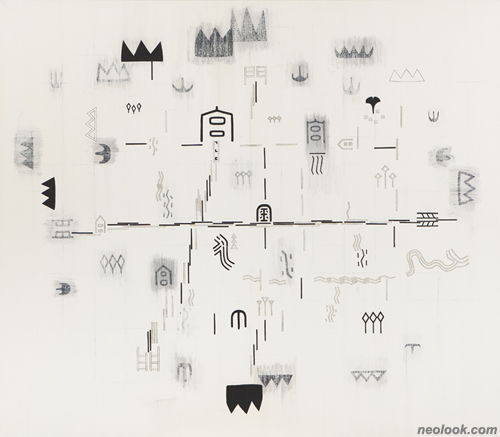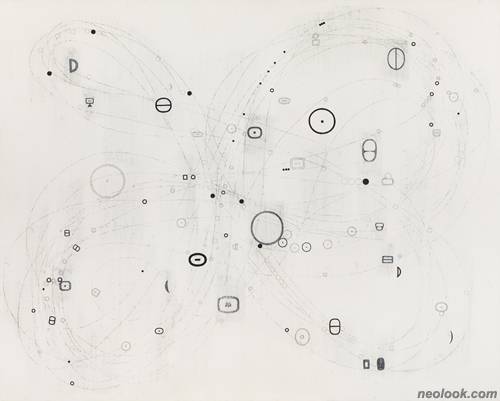- ● homepage
- ● archives
- ● restoration
- ● books
- ● big banners
- ● post board
- ■ neo's search
- ■ about us
- ■ 게재방법 안내
- 개인정보처리방침

- [email protected]
- Tel. 02_335_7922
- Fax. 02_335_7929
- 10:00am~04:30pm
- 월요일~금요일
- 3/3(월) 대체공휴일

문자산수 Character landscape painting
송윤주展 / SONGYUNJU / 宋倫朱 / painting 2011_1221 ▶ 2012_0105 / 일요일 휴관
● 위 이미지를 클릭하면 네오룩 아카이브 Vol.20091216d | 송윤주展으로 갑니다.
송윤주 블로그_blog.naver.com/juice129
초대일시 / 2011년_1221_수요일_06:00pm
후원 / 서울문화재단_한국문화예술위원회
관람시간 / 11:00am~07:00pm / 일요일 휴관
가회동60 GAHOEDONG60 서울 종로구 가회동 60번지 Tel. +82.(0)2.3673.0585 www.gahoedong60.com
파노라마적 화면의 시각적 재미와 율동 ● 작업의 초기부터 재료의 민감하고 세밀한 속성에 촉(觸)을 집중해온 작가 송윤주는 이번 전시를 통해 이미지와 기호의 접점에서 빚어지는 작품의 생태를 탐색한다. 출품작들은 크게 두 부류로 구분되는데 하나는 전지자적 관점에서 조망하는 풍경으로 볼 수 있는 시각의 표현이며, 다른 하나는 이러한 시각의 방향을 무한한 우주 공간으로 전환하여 보다 자유롭게 공간을 유영하는 듯한 작품들이다.

- 송윤주_해, 달, 산, 물, 나무 Sun, moon, mountains, water and tree_한지에 먹, 안료_41×41cm×5_2011
「서울」, 「죽정관학도」, 「산수몽」 등의 첫 번째 작품들은 마치 풍경화 혹은 지도처럼 표현된다. 작가는 먹과 종이를 가지고 표현하는 한국화적 특성이 동일한 원리로 표현되는 서예의 특성과 일치하는 것에 착안해서 고대 상형문자의 회화적 표현을 연구하여 작품에 도입하고 있다. 픽토그램 이미지들로 구성된 서울의 지도를 표현한 것 같은 작품 「서울」은 관람자들이 마치 보물찾기를 하는 듯한 시각으로 작품의 부분부분을 탐색하게 한다. 작가는 서울의 중심부에 자리 잡은 도로와 하천, 궁궐, 그리고 이런 구성요소들을 품에 안듯 감싸고 있는 외곽의 산들과 네 방향에 설치된 문들을 먹색의 농도를 조절한 고서체 한자의 다양한 모습으로 표현함으로써 글자의 의미작용과 그림의 표현기능을 함께 제시하고 있다.

- 송윤주_죽정관학도 竹亭觀鶴圖 JukJeongGwanHakDo_한지에 먹, 안료_130×162cm_2011
「죽정관학도」에서는 산으로 둘러싸인 정자가 화면 중앙에 놓여있고, 그 배경에는 대나무 숲이, 그리고 정자 앞에는 물위에 노니는 오리와 학으로 추측되는 동물들이 배치된 장면을 한 사람이 바라보고 있는 도가적인 정경을 송윤주의 방식으로 표현하고 있다. 작품 속에서 작가는 산이나 정자 등을 표현함에 있어서 다양한 모양을 제시함과 동시에 일부 글자의 표현에 표면을 문지르는 듯한 흔적을 가미함으로써 작가가 초기부터 탐구해 온 작품의 표면의 물성에 대한 관심이 이러한 작품들을 통해서도 이어져 오고 있으며 자신의 작품이 화면 전체를 하나의 이미지의 종합으로 보는 작가로서의 태도를 여전히 견지하고 있음을 보는 이들에게 주지시키고 있다.

- 송윤주_서울 Seoul_한지에 먹, 안료_140×160cm_2011

- 송윤주_산수몽 山水夢 Dream of Mountain and River_한지에 먹, 안료_91×91cm_2011
「산수몽」은 송윤주의 첫 번째 카테고리의 작품 가운데 가장 단순하면서도 서예와 회화의 협업을 통해 보여줄 수 있는 이미지의 성숙된 시점을 보여주는 듯한 작품이다. 무채색의 화면 속에 굵은 선으로 화면 상부를 지배하는 산의 모습은 글씨이면서 동시에 그림이고 현대적이면서 동시에 전통적인 먹의 힘을 보여준다. 화면 아랫부분의 물의 표현은 윗부분의 산의 표현에서 사용한 굵고 힘찬 선과 대조되는 실선을 사용하고 있는데 중간 중간에 굵게 표현된 파형의 선들은 상형문자로서의 한자의 물을 표현하는 글자임과 동시에 물에 비친 산의 모습을 재치있게 표현하고 있는 듯하다.

- 송윤주_송씨천문도 宋氏天文圖 Song's Astronomical Chart_한지에 먹, 안료_130×162cm_2011
두 번째 부류에 속하는 작품으로는 「해와 달」, 「송씨천문도」, 「카오스모스(chaosmos)」 등의 작품들을 들 수 있다. 앞선 풍경화 혹은 지도 형태의 작품들과 마찬가지로 이러한 작품들도 작가 특유의 기법으로 공들인 바탕화면에 단색조의 먹선이 작품구성의 틀을 유지하고 있다. 이러한 작품들을 통해 작가는 해와 달 등을 의미하는 상형문자의 베리에이션을 화면 구성의 중요한 이미지 요소로 채택하고 그로부터 해와 달이라는 우주의 중심 요소들에 대한 작가 고유의 해석과 변형으로 작품의 영역을 확장시키고 있다. 「해와 달」은 제목에 나타나 있는 그대로 해를 뜻하는 한자어 일(日)자와 달을 뜻하는 한자어 월(月)자의 다양한 모습들을 화면 속에 커다란 원형을 그리며 배치한 작품으로 상부의 반원에는 해의 이동 궤적을, 그리고 아래의 반원에는 달의 이동 궤적을 표현하고 있다. 하늘의 수많은 별들 가운데 우리 생명의 근원이자 자연 현상의 중심부를 차지하는 이러한 해와 달의 다채로운 모습을 제시한 이 작품에서 작가는 인간 생명의 근원과 우주의 진리 등에 다가서려는 작가의 촉수를 무한대의 공간으로 내밀고 있음을 보여준다. ● 「송씨천문도」와 「카오스모스(chaosmos)」는 이러한 우주적 현상에 대한 작가의 관심이 본격적으로 확대된 작업이라고 할 수 있다. 작가의 성을 딴 「송씨천문도」는 제목처럼 작가 개인이 바라보는 우주 행성의 진행 원리에 대한 명상과 탐조의 표현인 것이다. 해와 달의 상형문자들이 마치 쥐불놀이 불그릇의 궤적처럼 선형을 그리며 우주를 유영하는 이미지를 표현한 작품에서 시작한 송윤주의 천문도는 하늘의 수많은 별들이 제멋대로 빛나는 듯하면서도 그 나름의 질서를 보여주는 「카오스모스(chaosmos)」로 확대된다. 이 작품에서는 하늘뿐 아니라 지상의 모든 사물을 상징하는 상형문자들이 하나의 이미지 요소로 동원되어 작가가 그어놓은 우주 속의 궤도에 탑승한다. 신기하게도 작가의 명상과 탐색이 다채롭고 풍부한 이미지로 발전하는 작품 속에서 관람자들은 우주의 원리만큼이나 파노라마적 화면의 시각적 재미와 율동을 느낄 수 있게 된다. 이번 전시를 통해 송윤주는 이미지와 기호의 상호작용을 우리 주변의 환경에서 우주 공간으로 확장하여 무한공간 속에서 펼쳐지는 율동의 에너지로 표현하고 있다. 이제까지 작가가 견지해 온 한국화의 재료와 필법의 근간을 유지하면서 그 특징을 확장시켜 작가 특유의 독창적이면서 현대적 표현의 가능성을 보여주는 작품을 통해 송윤주는 한국화의 영역을 보다 풍부하게 가꾸어가고 있다. ■ 하계훈

- 송윤주_카오스모스 Chaosmos_한지에 먹, 안료_165×165cm_2011
Visual pleasure and rhythm within panoramic scenes ● A consistent part of Song Yun-ju's work has been the examination of the sensitive and subtle qualities of materials. In her upcoming exhibition she conjures up intersections between images and signs. The works that feature in the exhibition have been divided into two categories: works that present an all-encompassing view from an omniscient viewpoint; and works where the imagery appears to be free-floating, as if the viewpoint has been turned out toward infinite outer space. ● Works from the first category, such as Seoul, JukJeongGwanHakDo (竹亭觀鶴圖), and Dream of Mountain and River (山水夢) have parallels to landscape paintings or maps. Building upon the idea that Korean painting and calligraphy both use ink and paper, Song studied the painting-like characteristics of ancient pictographic characters and applied these qualities to her own artworks. Seoul, which is composed of pictographic images that can commonly be seen in maps of the city, encourages the viewer to closely examine every nook and cranny of the work, as if hunting for treasure. Song used a variety of old Chinese characters to depict the four gates to the North, South, East and West of the city, and the mountains on the outskirts, adjusting the densities of the ink color in the characters as they embrace the pathways, rivers, and palaces situated in the center of Seoul, thereby suggesting the functions of the characters on a semantic level and at the same time, on a symbolic level, the qualities of painting. ● JukJeongGwanHakDo features, at its center, a pavilion surrounded by mountains, with a bamboo forest behind it, while in front of the building a figure watches a scene in which ducks and cranes swim upon a lake. It creates a scene that, in Song's way, suggests a very Taoist painting-like landscape. In depicting elements such as mountains, or buildings in her work, Song suggests a variety of shapes. By adding specific marks to some letters, appearing as if rubbed into their surfaces she reflects her longstanding interest in the materiality of surfaces, clearly continuing through into this new series of work, whilst maintaining a perspective that presents the entire canvas as a composite of images. ● Even though it appears to present the simplest set of forms among these works belonging to the first category, Dream of Mountain and River demonstrates the way that images can be conjured up through intersections between calligraphy and painting The mountains that dominate the upper parts of the work, with their thick lines on the achromatic canvas, are both letters and pictures at the same time, as well as appearing both modern and yet traditional in its vigorous application of ink. In contrast with the thick, bold lines used for the mountains, the water in the lower part of the canvas has been depicted with fine lines, while the irregular thick strokes among them seem to be a Chinese letter, implying water as a pictograph, and at the same time, depicting the shape of the mountains as if reflected on the water. ● The second category for Song's work includes pieces such as Sun and Moon, Song's Astronomical Chart (宋氏天文圖), and Chaosmos. As seen in the works from the first category, which suggested the forms of landscape painting or maps, these paintings also employ a similar framework in their use of achromatic ink brushstrokes on a background presented in the artist's characteristic way. Song has selected variations of pictographic letters implying the sun and moon as primary images for composing the canvas, and attempted to broaden their boundaries through her own interpretation and transformation of such astronomical elements. ● As suggested in the title, the work Sun and Moon, takes variations of the Chinese characters 日 and 月 which represent the sun and moon, and arranges them in a large circular form, delineating the sun's trajectory in the upper half of the circle, and the moon's trajectory in the lower half. Suggesting a variety of aspects of the sun and moon, these natural phenomena that occupy a central position, among the innumerable stars in the sky, are a primary source of life. Sun and Moon suggests that Song is reaching out into infinite space, in order to come closer to the essence of human life and the truth of the Universe. ● Song's Astronomical Chart and Chaosmos show her broadening interest in these phenomena in the universe. Song's Astronomical Chart takes the artist's family name and incorporates her contemplation and observation of planetary movements in space. Song's Astronomical Chart developed from Gebulnori, a work in which the free-floating pictographic characters that represent the sun and moon delineate curvilinear forms, as if in the trajectory of its fire bowl. These ideas are expanded to Chaosmos, in which each of the countless stars in the sky shines in its own way, while at the same time they all operate within some sort of order. In Chaosmos, pictographic characters symbolize the way that all the things on Earth, as well as in the sky are brought up as elements of imagery, and put into the spatial orbit that the artist has delineated. In these works in which the artist's contemplation and observation develops into a variety of images, the viewer is encouraged to feel the visual pleasure and rhythm of the canvas, which create a panorama as expansive as the creation of the Universe. ● Through this exhibition, Song took a series of interactions between imagery and signs from our surrounding environment, and opened them up to depict the universe, creating rhythmic energy moving freely in the infinity of space. Having adhered to the basic principles of Korean painting, in terms of the materials and the types of brushstroke that the artist has continued to use, Song pushes its boundaries through an expanded approach to the characteristics of her idiosyncratic expressions. In this way she demonstrates the possibilities available to Korean painting, incorporating elements of contemporary art to further enrich the tradition. ■ Ha Gye-hun
Vol.20111221f | 송윤주展 / SONGYUNJU / 宋倫朱 / painting

